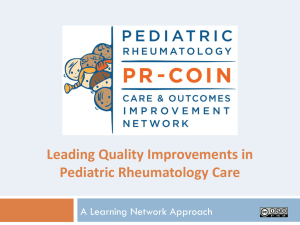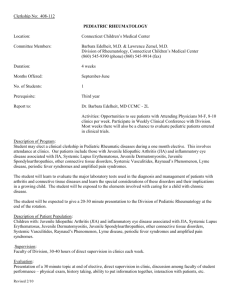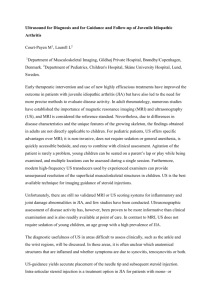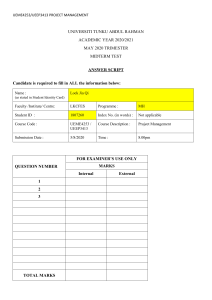Kuntze et al. - 2018 - Exercise Therapy in Juvenile Idiopathic Arthritis A Systematic Review and Meta-Analysis
advertisement
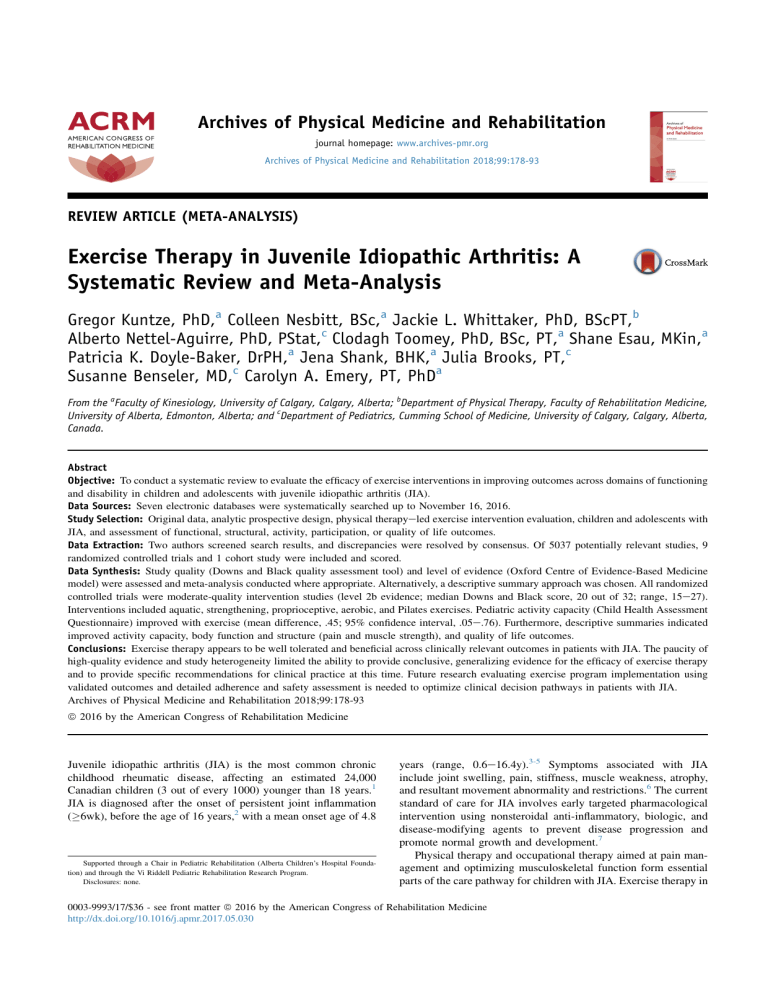
Archives of Physical Medicine and Rehabilitation journal homepage: www.archives-pmr.org Archives of Physical Medicine and Rehabilitation 2018;99:178-93 REVIEW ARTICLE (META-ANALYSIS) Exercise Therapy in Juvenile Idiopathic Arthritis: A Systematic Review and Meta-Analysis Gregor Kuntze, PhD,a Colleen Nesbitt, BSc,a Jackie L. Whittaker, PhD, BScPT,b Alberto Nettel-Aguirre, PhD, PStat,c Clodagh Toomey, PhD, BSc, PT,a Shane Esau, MKin,a Patricia K. Doyle-Baker, DrPH,a Jena Shank, BHK,a Julia Brooks, PT,c Susanne Benseler, MD,c Carolyn A. Emery, PT, PhDa From the aFaculty of Kinesiology, University of Calgary, Calgary, Alberta; bDepartment of Physical Therapy, Faculty of Rehabilitation Medicine, University of Alberta, Edmonton, Alberta; and cDepartment of Pediatrics, Cumming School of Medicine, University of Calgary, Calgary, Alberta, Canada. Abstract Objective: To conduct a systematic review to evaluate the efficacy of exercise interventions in improving outcomes across domains of functioning and disability in children and adolescents with juvenile idiopathic arthritis (JIA). Data Sources: Seven electronic databases were systematically searched up to November 16, 2016. Study Selection: Original data, analytic prospective design, physical therapyeled exercise intervention evaluation, children and adolescents with JIA, and assessment of functional, structural, activity, participation, or quality of life outcomes. Data Extraction: Two authors screened search results, and discrepancies were resolved by consensus. Of 5037 potentially relevant studies, 9 randomized controlled trials and 1 cohort study were included and scored. Data Synthesis: Study quality (Downs and Black quality assessment tool) and level of evidence (Oxford Centre of Evidence-Based Medicine model) were assessed and meta-analysis conducted where appropriate. Alternatively, a descriptive summary approach was chosen. All randomized controlled trials were moderate-quality intervention studies (level 2b evidence; median Downs and Black score, 20 out of 32; range, 15e27). Interventions included aquatic, strengthening, proprioceptive, aerobic, and Pilates exercises. Pediatric activity capacity (Child Health Assessment Questionnaire) improved with exercise (mean difference, .45; 95% confidence interval, .05e.76). Furthermore, descriptive summaries indicated improved activity capacity, body function and structure (pain and muscle strength), and quality of life outcomes. Conclusions: Exercise therapy appears to be well tolerated and beneficial across clinically relevant outcomes in patients with JIA. The paucity of high-quality evidence and study heterogeneity limited the ability to provide conclusive, generalizing evidence for the efficacy of exercise therapy and to provide specific recommendations for clinical practice at this time. Future research evaluating exercise program implementation using validated outcomes and detailed adherence and safety assessment is needed to optimize clinical decision pathways in patients with JIA. Archives of Physical Medicine and Rehabilitation 2018;99:178-93 ª 2016 by the American Congress of Rehabilitation Medicine Juvenile idiopathic arthritis (JIA) is the most common chronic childhood rheumatic disease, affecting an estimated 24,000 Canadian children (3 out of every 1000) younger than 18 years.1 JIA is diagnosed after the onset of persistent joint inflammation (6wk), before the age of 16 years,2 with a mean onset age of 4.8 Supported through a Chair in Pediatric Rehabilitation (Alberta Children’s Hospital Foundation) and through the Vi Riddell Pediatric Rehabilitation Research Program. Disclosures: none. years (range, 0.6e16.4y).3-5 Symptoms associated with JIA include joint swelling, pain, stiffness, muscle weakness, atrophy, and resultant movement abnormality and restrictions.6 The current standard of care for JIA involves early targeted pharmacological intervention using nonsteroidal anti-inflammatory, biologic, and disease-modifying agents to prevent disease progression and promote normal growth and development.7 Physical therapy and occupational therapy aimed at pain management and optimizing musculoskeletal function form essential parts of the care pathway for children with JIA. Exercise therapy in 0003-9993/17/$36 - see front matter ª 2016 by the American Congress of Rehabilitation Medicine http://dx.doi.org/10.1016/j.apmr.2017.05.030
